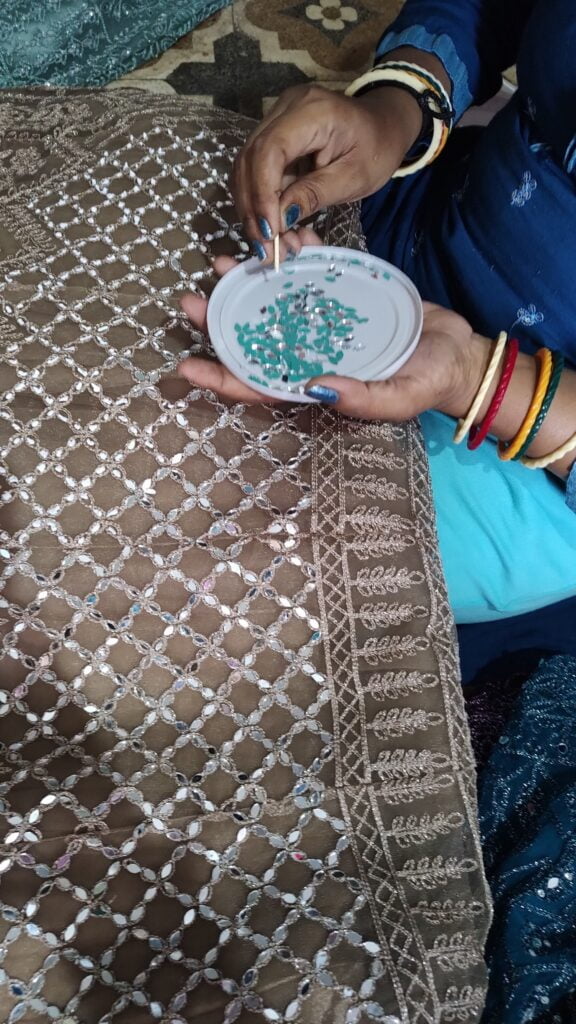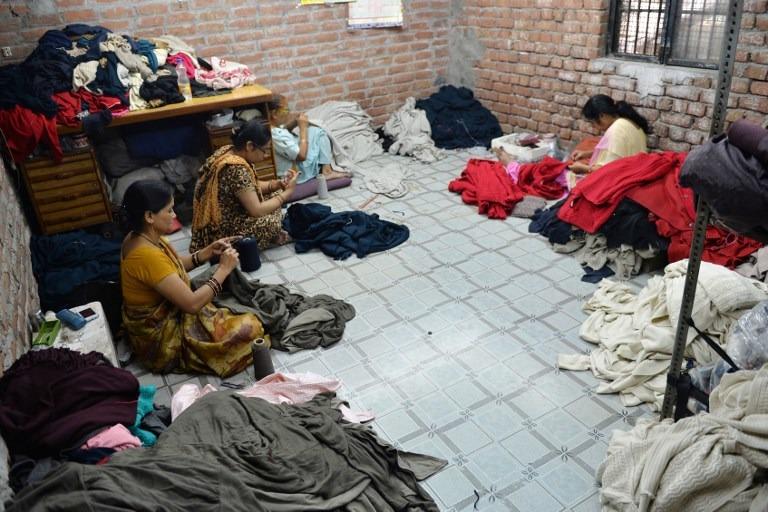Alma lives in Ahmedabad in a small housing unit of 45 sq. meters with 17 of her other household members. She is a home-based worker along with her two sisters-in-law and husband who all make kites inside their housing unit.
She receives a daily target of 1000 kites from the contractor (located approx. 3km from her house) for which she has to paste the central stick to the kite. She is paid a sum of Rs. 110 per 1000 kites she works upon. She’s been part of manufacturing kites for the last 25 years.
Alma constitutes 11 percent of India’s workforce whose employment comes from home-based work. Home-based work is informal employment in which workers are made vulnerable by the invisibility of the work, lack of labour law protections to govern employment contracts and social security, and the place of work, i.e, ’the home’.

As per the ILO definition, home-based workers include all workers who carry out remunerative work within their homes or in an adjacent location that is not the workplace of the employer. A statistical brief released by a global research and policy network called Women in Informal Employment: Globalising and Organising (WIEGO) in 2020, mentions that in India, over half (53 percent) of women home-based workers work as many as 36 hours per week in home-based work alone. Over a quarter (29 percent) of women work 43 hours or more. Also, the average hourly earnings of male home-based workers are twice that of women home-based workers.
Climate change, in so far as it affects temperature and rain patterns, may render entire regions unproductive and make workplaces too hot for work, thereby leading to climate-induced migration, the proliferation of precarious and informal work, and an increase in unemployment
The sexual division of work is embedded in the very nature of home-based work. Home-based work is predicated on the fact that women are tied to the home because of domestic care work and limited access to work outside of the home.
Social restrictions don’t prohibit women from working, but they prohibit them from working outside the home. The sexual division of labour leads to unrecognised and precarious ‘sexual division of space of work’.
In the context of homeworkers, some do it to ensure survival and in other cases, in their own words, ‘do it to pass their free time‘ (India Exclusion report, 2017). Apart from the cultural perception of women’s role, it is the flexible nature of the work and the space they are carried out in, that make them internalise the idea that they aren’t ‘labourers’. Neither the family nor the women themselves recognise their own selves as labourers and just see their work as a ‘productive-time pass’. This also limits the women’s ability to further unionise against unjust work conditions.

As part of the urban working poor, home-based workers live in informal settlements which are characterised by overcrowding and poor infrastructure. Their houses, which are also their place of work, are often small and cramped.
The inadequacy of their housing unit becomes a hindrance to undertaking home-based work. It is also important to note that most of the home-based workers live in rented houses. They pay a considerable amount of their income every month as rent to the landlord.
Also read: Environmental Crisis And Gender: The Effects Of Climate Change On Women’s Gynaecological Health
While many workers own their houses, they live in informal settlements and fear demolition. The roofs and walls are often not of a permanent nature and hence they leak, causing damage to the house and goods, including the raw materials stored.
Infrastructure services are missing—there is no individual water connection or drainage, sanitation is poor, and often there is no adequate garbage collection. For home-based workers, their poor housing conditions equate to poor working conditions and the deficits in housing and urban infrastructure have grave economic consequences for them.
With the increased impact of climate change, the question of the adequacy of housing for home-based workers is a relevant question to ask. With the rising frequency of extreme weather events, the impact of climate change on their housing directly impacts their work.

Alma mentioned how working in peak summers is extremely discomforting as the temperature of the house increases. Due to the thin material of the kites, she can’t operate a fan while working. Alma and her sisters-in-law are also the caregivers of the household. Hence, they only have time between 12:00 am and 6:00 pm to complete the set target of kites.
Where home-based workers already live in precarious conditions, these workers occupy the bottom links of value chains, earning little and having to pay the overhead costs of production such as space, utilities, and equipment. Irregular work orders, arbitrary rejection of goods, and delayed payments are common. Poor quality urban settlements and the increased impact of climate change create a dual disability for home-based workers. Hence, it becomes important to address housing for the marginalised not just as an idea to live, but also to work
This is also the time of the day when the temperature of the day is at its peak. This further pushes Alma to work at night when the temperature is low. But working at night also gets hindered because of prevailing lethargy from the day and lack of limited sleeping space in the household. Refusing contractors for work is also not an option as their work contributes a significant share to the household income.
She further mentioned how Ahmedabad received a longer monsoon this time, because of which she also had to bear dampness in her household. “Barish ke mosaam mai silan se kagaz gal jaata hai. Yaha tak ki farsh mai se bhi nami nikalti hai. Niche beth kar kaam karna bhi mushkil ho jaata hai” (During the rainy season, the paper gets wet due to dampness. Even the moisture comes out from the floor. It becomes difficult to work sitting down). Further, leakages from the roof also make difficult to store raw material. Losses of materail also had to be borne by Alma herself, which adds to her hesitancy in taking work in the monsoon. The lack of storage space in her housing is also a major issue for Alma in conducting her work.
Excessive heat and rain have an adverse impact on the work of Alma. As she says, “Garmi nahi hoti to ek din me 1500 patang bhi kar leti hu” (In case of no heat, I can also do 1500 kites in a day). Further, she does not get time to relax after her husband and children set off for work or school.
The impacts of climate change will continue to worsen, cautions the latest report of the United Nations Intergovernmental Panel on Climate Change (IPCC). In Ahmedabad, by 2035, 11 million people would be at a high risk of living in an urban heat island, with much higher temperatures than nearby areas. The risks from heat stress will be higher for those living without adequate places to live or work.

Kanchan is another home-based worker living in the eastern suburbs of Ahmedabad city. For the past 20-25 years, Kanchan has been packaging spoons out of her home for a nearby Industry. She receives payment of Rs. 25 for every 10kg of spoons. She lives in a single-room house of 20 sq.m. with a toilet and veranda outside.
The roofing on the room is of asbestos with the kitchen located in one corner of the room. The room performs multiple functions for the family from cooking, sleeping, studying, and working during the day. Due to the asbestos roofing, the heat in summer gets entrapped in the house, making it even hotter from the outdoors.
Packaging spoons radiates toxins and chemicals which gets even worse with the increased temperature. Working at night is also not an option as the light causes a similar burning effect to Kalpana’s eyes. Hence, the only alternative for her is to sit outside for work. Kanchan has lost her credibility with the contractor as she’s not able to deliver on time. She thus decided to take a break from work till the summer lasts.
Before packaging spoons, she used to perform stone pasting work on blouses. She left doing the same as she quotes, “Mai ab blouses par kaam nahi karti. Mujhe 15-25 rupee milte the ek blouse ka. Par stone par istemaal hone wali goond ko samay lagta hai sukhne mai. Ghar ke tapmann ke karan vo sukhti ho nahi thi. Aur sukhaniye ke liye zyada jagah bhi nahi hai”, (Now I don’t work on blouses. I used to earn 15-25 rupees per blouse. But stone pasting glue takes time to get dry. Due to heat inside the home, it won’t dry easily. Also drying blouses require space inside the house).
Home-based work can make already precarious living situations more unsafe by reducing the amount of space in the home and by introducing chemicals, fumes, or hazardous materials used in the work. Further, safe, healthy and decent working conditions depend on the absence of environmental hazards (such as storms and air pollution) and the maintenance of environmental stability (such as temperatures staying within a particular range and predictable precipitation patterns).
Climate change, in so far as it affects temperature and rain patterns, may render entire regions unproductive and make workplaces too hot for work, thereby leading to climate-induced migration, the proliferation of precarious and informal work, and an increase in unemployment.
The seasonal nature of the jobs of home-based work also has a profound implication on earnings. Global climate change is expected to make the seasons more unpredictable and bring in abnormal weather patterns, which will have a significant impact on the lives and livelihoods of home-based workers. This is specifically true in the case of garment workers.
For example, Sinha and Mehrotra highlight how changing fashion trends and short lead times can affect homeworkers in the garment sector. As one homeworker in Delhi explains, “The company changes the design many times, so we have to do multiple alterations, for which we are not paid extra.”
Where home-based workers already live in precarious conditions, these workers occupy the bottom links of value chains, earning little and having to pay the overhead costs of production such as space, utilities, and equipment. Irregular work orders, arbitrary rejection of goods, and delayed payments are common. Poor quality urban settlements and the increased impact of climate change create a dual disability for home-based workers. Hence, it becomes important to address housing for the marginalised not just as an idea to live, but also to work.
About the author(s)
Anuj is an urban practitioner and an independent writer. He's mostly interested in Feminist Urbanism and the intersection of various identities in the urban. He is a graduate of the Indian Institute for Human Settlements and has disciplinary training in Urban and Regional planning.




